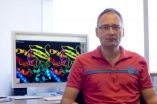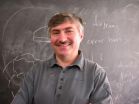Closing hole in the heart no better than drugs in preventing strokes
Loyola was major enroller in landmark clinical trial
2012-03-19
(Press-News.org) MAYWOOD, Il. -- Loyola University Medical Center is one of the major enrollers in a landmark clinical trial that found that plugging a hole in the heart works no better than drugs in preventing strokes.
The study is published in the New England Journal of Medicine. Loyola enrolled 24 patients, one of the highest patient enrolments in the multicenter trial, and more than any other Chicago-area hospital. Principal investigators at the Loyola site are stroke specialist Dr. Michael Schneck and interventional cardiologist Dr. Fred Leya.
About 1 in 4 adults has a small hole in the wall that separates the top two chambers of the heart. It's called a patent foramen ovale (PFO). For most people, a PFO poses no problems. But in some cases, a clot can pass through the hole, migrate to the brain and trigger a stroke.
The standard treatment is medication to prevent blood clots, typically aspirin or Coumadin. A newer treatment is to plug the hole with a device delivered by a catheter. The catheter is inserted into a blood vessel at the top of the leg and guided up to the heart. When the catheter reaches the PFO, the device is deployed, opening like an umbrella to plug the hole.
The clinical trial included 909 patients who had PFOs, and had previously suffered strokes or mini strokes called transient ischemic attacks (TIAs). They were randomly assigned to receive a PFO closure device plus blood thinners or drug therapy alone.
The closure device worked no better than drugs alone in preventing recurrent strokes or TIAs. Moreover, major vascular complications occurred in 3.2 percent of the closure group.
"Medical therapy is just as good as the device," Schneck said. "The larger lesson is that we have an impetus in the United States for doing procedures without first standing back and asking all the right questions."
Leya noted the clinical trial used an older version of a closure device. "I would like to see more research to determine if better devices will have better results," he said.
### Schneck is medical director of the Neurosciences Intensive Care Unit and a professor in the Departments of Neurology and Neurological Surgery of Loyola University Chicago Stritch School of Medicine.
Leya is medical director of Cardiac Catheterization Laboratories and Interventional Cardiology and a professor in the Department of Medicine, Division of Cardiology of Loyola University Chicago Stritch School of Medicine.
ELSE PRESS RELEASES FROM THIS DATE:
2012 Internal Medicine Residency match virtually unchanged from 2011
2012-03-19
PHILADELPHIA -- The number of U.S. medical student seniors at medical schools choosing internal medicine residencies leveled in 2012 after two years of significant increases. According to the 2012 National Resident Matching Program, 2,941 U.S. medical school seniors matched internal medicine, nearly unchanged from 2011 when 2,940 matched internal medicine.
"After seeing increases in 2010 and 2011 for the internal medicine residency match for U.S. medical students, we are disappointed that there was not a bigger increase this year," said Virginia L. Hood, MBBS, MPH, FACP, ...
Mesquite trees displacing Southwestern grasslands
2012-03-19
As the desert Southwest becomes hotter and drier, semi-arid grasslands are slowly being replaced by a landscape dominated by mesquite trees, such as Prosopis velutina, and other woody shrubs, a team of University of Arizona researchers has found.
In a "leaf-to-landscape" approach, the team combined physiological experiments on individual plants and measurements across entire ecosystems to quantify how well grasslands, compared to mesquite trees and woody shrubs, cope with heat and water stress across seasonal precipitation periods.
"Our results show that even the smallest ...
Researchers reveal how a single gene mutation leads to uncontrolled obesity
2012-03-19
Washington, D.C. -- Researchers at Georgetown University Medical Center have revealed how a mutation in a single gene is responsible for the inability of neurons to effectively pass along appetite suppressing signals from the body to the right place in the brain. What results is obesity caused by a voracious appetite.
Their study, published March 18th on Nature Medicine's website, suggests there might be a way to stimulate expression of that gene to treat obesity caused by uncontrolled eating.
The research team specifically found that a mutation in the brain-derived ...
Need for speed
2012-03-19
Like any law-abiding train passenger, a molecule called oskar RNA carries a stamped ticket detailing its destination and form of transport, scientists at the European Molecular Biology Laboratory (EMBL) in Heidelberg, Germany, have found. They show that for this molecule, moving in the right direction isn't enough: speed is of the essence. Their study, published online today in Nature Structural & Molecular Biology, also provides clues as to how a single molecule could receive tickets for different destinations, depending on what type of cell it is in.
For a fruit fly ...
Miami Defense Attorney Diana Gonzalez Runs for Judge
2012-03-19
Ferrer Shane, PL is proud to announce that one of its attorneys, Diana E. Gonzalez, is running for Miami-Dade County Court Judge.
Starting her career in 2004, Diana Gonzalez was rapidly promoted up the ranks in the Public Defender's Office, first handling misdemeanor charges, then defending young people in the juvenile division, to ultimately defending clients charged with the most serious felonies - all in the span of just five years, trying everything from a traffic ticket to a murder case.
Having traveled abroad with the U.S. Department of Defense and with USAID ...
New insight into mechanisms behind autoimmune diseases suggests a potential therapy
2012-03-19
LA JOLLA, Calif., March 18, 2012 – Autoimmune diseases, such as Type I diabetes and rheumatoid arthritis, are caused by an immune system gone haywire, where the body's defense system assaults and destroys healthy tissues. A mutant form of a protein called LYP has been implicated in multiple autoimmune diseases, but the precise molecular pathway involved has been unknown. Now, in a paper published March 18 in Nature Chemical Biology, researchers at Sanford-Burnham Medical Research Institute (Sanford-Burnham) show how the errant form of LYP can disrupt the immune system. ...
UMass Amherst theoretical physicists find a way to simulate strongly correlated fermions
2012-03-19
AMHERST, Mass. – Combining known factors in a new way, theoretical physicists Boris Svistunov and Nikolai Prokof'ev at the University of Massachusetts Amherst, with three alumni of their group, have solved an intractable 50-year-old problem: How to simulate strongly interacting quantum systems to allow accurate predictions of their properties.
It could open the door to practical superconductor applications, as well as to solving difficult "many-body" problems in high-energy physics, condensed matter and ultra-cold atoms.
The theoretical breakthrough by Prokof'ev and ...
Improving Your Doctor's Hygiene
2012-03-19
When people don't feel well, they see a doctor. They probably assume that the doctor will not spread anything to them to make them sicker. Ohio residents may be disturbed to find out that hygiene in hospitals is not as high of a priority as one would expect.
Hospital-acquired infections are the fourth leading cause of death in the United States. A 2004 study done by the American College of Physicians found that only 57 percent of doctors washed their hands when they were supposed to. The study also showed that the busier the doctor was and the more patients needing ...
Columbia Engineering and Penn researchers increase speed of single-molecule measurements
2012-03-19
New York, NY—March 18, 2012—As nanotechnology becomes ever more ubiquitous, researchers are using it to make medical diagnostics smaller, faster, and cheaper, in order to better diagnose diseases, learn more about inherited traits, and more. But as sensors get smaller, measuring them becomes more difficult—there is always a tradeoff between how long any measurement takes to make and how precise it is. And when a signal is very weak, the tradeoff is especially big.
A team of researchers at Columbia Engineering, led by Electrical Engineering Professor Ken Shepard, together ...
A surprising new kind of proton transfer
2012-03-19
When a proton – the bare nucleus of a hydrogen atom – transfers from one molecule to another, or moves within a molecule, the result is a hydrogen bond, in which the proton and another atom like nitrogen or oxygen share electrons. Conventional wisdom has it that proton transfers can only happen using hydrogen bonds as conduits, "proton wires" of hydrogen-bonded networks that can connect and reconnect to alter molecular properties.
Hydrogen bonds are found everywhere in chemistry and biology and are critical in DNA and RNA, where they bond the base pairs that encode genes ...
LAST 30 PRESS RELEASES:
URI researchers uncover molecular mechanisms behind speciation in corals
Chitin based carbon aerogel offers a cleaner way to store thermal energy
Tracing hidden sources of nitrate pollution in rapidly changing rural urban landscapes
Viruses on plastic pollution may quietly accelerate the spread of antibiotic resistance
Three UH Rainbow Babies & Children’s faculty elected to prestigious American Pediatric Society
Tunnel resilience models unveiled to aid post-earthquake recovery
Satellite communication systems: the future of 5G/6G connectivity
Space computing power networks: a new frontier for satellite technologies
Experiments advance potential of protein that makes hydrogen sulfide as a therapeutic target for Alzheimer’s disease
Examining private equity’s role in fertility care
Current Molecular Pharmacology achieves a landmark: real-time CiteScore advances to 7.2
Skeletal muscle epigenetic clocks developed using postmortem tissue from an Asian population
Estimating unemployment rates with social media data
Climate policies can backfire by eroding “green” values, study finds
Too much screen time too soon? A*STAR study links infant screen exposure to brain changes and teen anxiety
Global psychiatry mourns Professor Dan Stein, visionary who transformed mental health science across Africa and beyond
KIST develops eco-friendly palladium recovery technology to safeguard resource security
Statins significantly reduce mortality risk for adults with diabetes, regardless of cardiovascular risk
Brain immune cells may drive more damage in females than males with Alzheimer’s
Evidence-based recommendations empower clinicians to manage epilepsy in pregnancy
Fungus turns bark beetles’ defenses against them
There are new antivirals being tested for herpesviruses. Scientists now know how they work
CDI scientist, colleagues author review of global burden of fungus Candida auris
How does stroke influence speech comprehension?
B cells transiently unlock their plasticity, risking lymphoma development
Advanced AI dodel predicts spoken language outcomes in deaf children after cochlear implants
Multimodal imaging-based cerebral blood flow prediction model development in simulated microgravity
Accelerated streaming subgraph matching framework is faster, more robust, and scalable
Gestational diabetes rose every year in the US since 2016
OHSU researchers find breast cancer drug boosts leukemia treatment
[Press-News.org] Closing hole in the heart no better than drugs in preventing strokesLoyola was major enroller in landmark clinical trial






